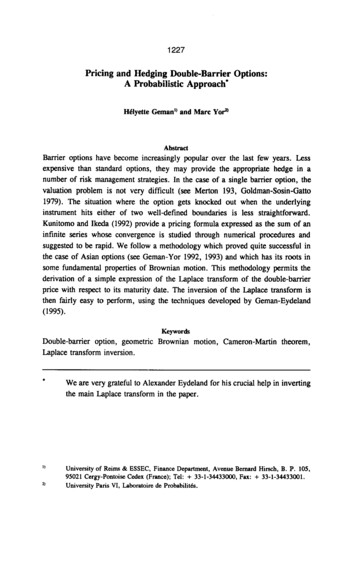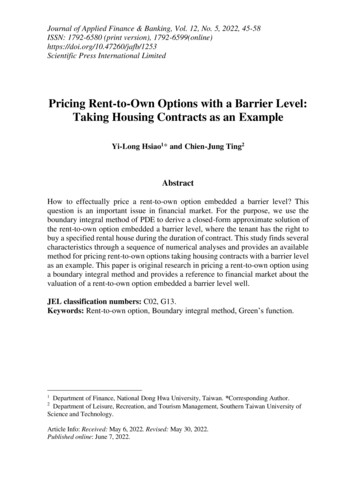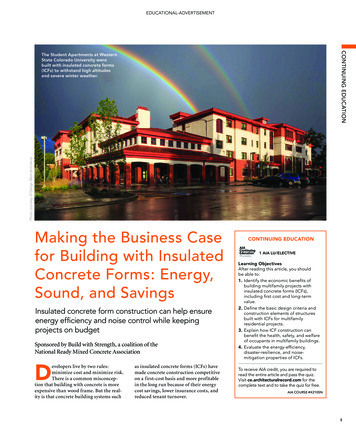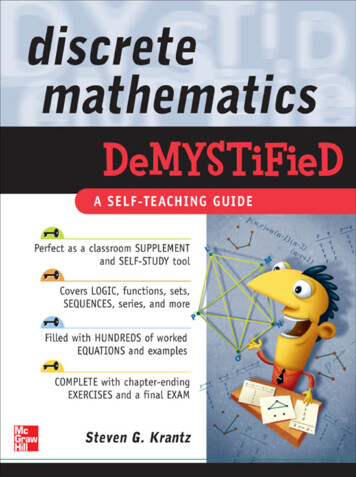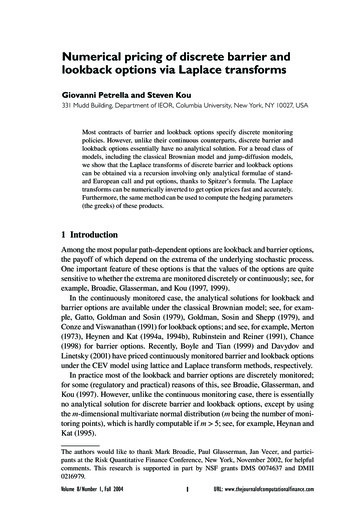
Transcription
Numerical pricing of discrete barrier andlookback options via Laplace transformsGiovanni Petrella and Steven Kou331 Mudd Building, Department of IEOR, Columbia University, New York, NY 10027, USAMost contracts of barrier and lookback options specify discrete monitoringpolicies. However, unlike their continuous counterparts, discrete barrier andlookback options essentially have no analytical solution. For a broad class ofmodels, including the classical Brownian model and jump-diffusion models,we show that the Laplace transforms of discrete barrier and lookback optionscan be obtained via a recursion involving only analytical formulae of standard European call and put options, thanks to Spitzer’s formula. The Laplacetransforms can be numerically inverted to get option prices fast and accurately.Furthermore, the same method can be used to compute the hedging parameters(the greeks) of these products.1 IntroductionAmong the most popular path-dependent options are lookback and barrier options,the payoff of which depend on the extrema of the underlying stochastic process.One important feature of these options is that the values of the options are quitesensitive to whether the extrema are monitored discretely or continuously; see, forexample, Broadie, Glasserman, and Kou (1997, 1999).In the continuously monitored case, the analytical solutions for lookback andbarrier options are available under the classical Brownian model; see, for example, Gatto, Goldman and Sosin (1979), Goldman, Sosin and Shepp (1979), andConze and Viswanathan (1991) for lookback options; and see, for example, Merton(1973), Heynen and Kat (1994a, 1994b), Rubinstein and Reiner (1991), Chance(1998) for barrier options. Recently, Boyle and Tian (1999) and Davydov andLinetsky (2001) have priced continuously monitored barrier and lookback optionsunder the CEV model using lattice and Laplace transform methods, respectively.In practice most of the lookback and barrier options are discretely monitored;for some (regulatory and practical) reasons of this, see Broadie, Glasserman, andKou (1997). However, unlike the continuous monitoring case, there is essentiallyno analytical solution for discrete barrier and lookback options, except by usingthe m-dimensional multivariate normal distribution (m being the number of monitoring points), which is hardly computable if m 5; see, for example, Heynan andKat (1995).The authors would like to thank Mark Broadie, Paul Glasserman, Jan Vecer, and participants at the Risk Quantitative Finance Conference, New York, November 2002, for helpfulcomments. This research is supported in part by NSF grants DMS 0074637 and DMII0216979.Volume 8/ Number 1, Fall 20041URL: www.thejournalofcomputationalfinance.com
2Giovanni Petrella and Steven KouBecause of this, various numerical methods have been proposed for discretebarrier and lookback options under the classical Brownian model, including, forexample, lattice methods (Babbs, 1992; Boyle and Lau, 1994; Cheuk and Vorst,1997; Hull and White, 1993; Kat, 1995; and Ritchken, 1995) and numerical integration (AitSahlia and Lai, 1997; Sullivan, 2000; Tse et al, 2001).Broadie, Glasserman and Kou (1997, 1999) propose an enhanced trinomial treemethod and develop analytical approximations to relate the prices of continuousand discrete lookback and barrier options under the classical Brownian model.(Chuang, 1996, also independently suggested the approximation for barrier optionsin a heuristic way.) The derivation in Broadie et al (1997) for discrete barrieroptions is further simplified and extended in Hörfelt (2003) and Kou (2003). Theapproximations are very simple to use and give very good results when the numberof monitoring points is large; however, they may not be sufficiently accurate whenthere is a limited number of monitoring points or the option is close to maturity.The enhanced trinomial trees may still be time-consuming. Furthermore, it is notclear how to generalize the results outside the classical Brownian setting.In an interesting paper Ohgren (2001) shows how to compute the characteristicfunction of the discretely monitored maximum stock price, by using the celebratedSpitzer’s (1956) formula, and then uses the result to price discrete lookbacks at theinception of the contract and at monitoring points (but not at any generic point intime), if the previous achieved maximum (minimum) stock price can be ignored.In this paper, building on the result in Ohgren (2001) and the Laplace transform(with respect to strike prices) introduced in Carr and Madan (1999), we develop amethod based on Laplace transform that easily allows us to compute the price andhedeging parameters (the Greeks) of discretely monitored lookback and barrieroptions at any point in time, even if the previous achieved maximum (minimum)cannot be ignored. The proposed method has several distinctive features: It allows us to compute, via a simple recursion only involving the standardEuropean call and put options, the Laplace transforms of the discrete barrierand lookback options; see Sections 3 and 4. The Laplace transforms can then be numerically inverted easily via a twosided Euler algorithm, and the inversion is fast and accurate; see Section 5 andAppendix B. The method can compute the prices of barrier and lookback options at any timepoint (not just at the monitoring points and at the inception of the contract).Because of this flexibility, we are also able to compute, at almost no additionalcomputational cost, the main hedging parameters (the Greeks); see Sections 3and 4. It can be implemented not only under the classical Brownian model, but alsounder more general models (eg, jump-diffusion models) with stationary independent increaments; see Section 5.After the paper had been accepted by the journal, we found out that a similarmethod using Fourier transforms in the case of pricing discrete lookback optionsURL: thejournalofcomputationalfinance.comJournal of Computational Finance
Numerical pricing of discrete barrier and lookback options via Laplace transformsat the monitoring points (but not at any time points, hence with no discussion ofthe hedging parameters) was independently suggested on pp. 893–4 in Borovkovand Novikov (2002). The method proposed here is more general, as it is applicableto the pricing of both discrete lookback and barrier options at any time points (andhence to the computing of the hedging parameters).The rest of the paper is organized as follows. Section 2 introduces somenotations. Laplace transforms are derived in Section 3. The main algorithmis summarized in Section 4. We then show in Section 5 how to implement thealgorithm and provide some numerical results. Appendix A discusses possibleextensions of our methodology to various products. Details on the Laplace inversion algorithms are deferred to Appendix B.The reader who is mainly interested in practical aspects of the method maywant to go directly to the algorithm in Section 4 and then to the numerical examples in Section 5.2 Notation2.1 Lookback optionsA standard (also called floating) lookback call (put) gives the option holderthe right to buy (sell) an asset at its lowest (highest) price during the life of theoption. In a discrete time setting the minimum (maximum) of the asset price willbe determined at discrete monitoring instants. We assume that the monitoringinstants are equally spaced in time. More precisely, consider the asset value S(t),monitored in the interval [0, T] at a sequence of equally spaced monitoring points,0 t(0) t(1) t(m) T. Let Xi : log{S(t(i)) S(t(i –1))}, where Xi is thereturn between t(i –1) and t(i), andSk : S ( t ( k )) Sk 1e Xk S0 e( X1 Xk ), k 0 ,1, , m(1)Introduce the maxima and minima of the asset price only at the monitoringpoints,Mt ( l ), t ( k ) : max Sj , 0 l k m; M 0 ,T : max Sk , m0 ,T : min Sk (2)l j k0 k m0 k mAt any time t, lying between the (l – 1)th and lth monitoring points, ie,(t(l – 1)) t t(l)standard finance theory gives the values of the standard (floating) lookback calland put option at any time t [0,T] asLC ( t , T ) e r ( T t ) E * S ( T ) m0 ,T Ft ,L P ( t , T ) e r ( T t ) E * M S ( T ) Ft 0 ,Trespectively, where r is the risk-free interest rate and E* represents the expectationunder the risk-neutral measure (the measure could be specified by arbitrage arguVolume 8/ Number 1, Fall 2004URL: www.thejournalofcomputationalfinance.com3
4Giovanni Petrella and Steven Kouments for the Brownian model or by equilibrium arguments for general models).In the same way, at any time t [0,T], for the fixed strike put and call we haveFP(t, T ) e–r (T– t) E*[(K – m 0,T) Ft] and FC(t, T ) e–r (T– t) E*[(M0,T – K) Ft].Other types of lookback options include percentage lookbacks in which theextreme values are multiplied by a constant, and partial-lookback options inwhich the monitoring interval for the extremum is a subinterval of [0, T ]. We willnot attempt to price such derivatives and refer the interested reader to Andreasen(1998) for a detailed description.2.2 Barrier optionsBarrier options can be classified according to whether the asset price needsto pass or to avoid a certain level to receive a payoff. In the first case they arecalled knock-in options, in the second knock-out. For example, the up-and-outcall and put options (UOC and UOP from now on) with strike K, barrier H andmaturity T, have payoffs (S(T) – K) 1{M0,T H} and (K – S(T)) 1{M0,T H}, where1{·} is the indicator function of the event {·}. Similarly, up-and-in call and putoptions (UIC and UIP from now on) with the same parameters have payoffs(S(T) – K) 1{M0,T H} and (K – S(T)) 1{M0,T H}. Down-and-in and down-andout options have a similar structure with M0,T substituted by m 0,T. As seen forlookbacks, we can value barrier options by taking the discounted expected valueof the payoff at maturity under the risk-neutral measure; for example, the price ofan up-and-out put option is(3)UOP ( t , T ) e r ( T t ) E * ( K S ( T )) 1{ MFt 0 ,T H }All other barrier options can be priced in the same way.2.3 Some mathematical notationDefine the maxima of the return process between the monitoring points to be i l 1 X i ,l j k : max ( 0 , X , X XMl,kl 1 l 1l 2 , , Xl 1 X k) maxjl 0 , , kwhere we have used the convention that the sum is zero if the index set is empty.Throughout the paper, we shall assume that X1, X2, , are independent identicallydistributed (iid) random variables. With Xs, t : log{S(t) S(s)} being the returnbetween time s and time t, t s, defineA( u; t ) : E * euYlt, m xl, mE * euXt , t ( l ) ,Ylt, m : Xt , t ( l ) M l, m (u v)C ( u , v; t ) : E * euXt , t ( l ) E * euMl, m vXt ,T xˆl , mE * e Xt, t ( l ) (4)(5)where xl , k : E * [ euMl, k ] , xˆl , k : E * euMl, k vBl, k , l k ; Bl , k : URL: thejournalofcomputationalfinance.com ik l 1 Xi(6)Journal of Computational Finance
Numerical pricing of discrete barrier and lookback options via Laplace transforms3 Laplace transforms for discrete lookback and barrier options3.1 Characteristic function computationThe results in this subsection generalize the results in Ohgren (2001) by showinghow to compute xl, k and x̂ l, k (6) recursively via Spitzer’s formula for the sum ofiid random variables.LEMMA 1 Define for 0 l k,al , k : E * eu Bl, k , aˆl , k : E * e( u v ) Bl, k E * e v Bl, k 1, u , v C (7)where B l, k and B l,– k denote the positive and negative part of the Bl, k , respectively.Then for any given l, we havexl, k 1 xˆl, k 1 1k l 11k l 1k l al, k 1 j xl, l j(8)j 0k l aˆl, k 1 j xˆl, l j(9)j 0PROOF Equation (8) is a slight generalization of the recursion given in Ohgren(2001), in which the case l 0 is discussed. To show (9), first note that Spitzer(1956) also proves that, for s 1 and u, v C, with Im (u) 0 and Im (v) 0: k 0s k E * e k s E * e( u v ) Bl , k E * e v Bl , k 1 exp k k 1 v B uMl, kl, k() (10) We can again extend (10) to any u, v C, by limiting s s′0 for some s′0small enough. In fact, the result will still hold for s s′0 1 c′, with c′ max (E*[e L′ X ], 2cX), where L′ 2 max( u , v ) and(cX max E * e L ′ Bl, k , E * e L ′ Bl, k )Now (9) follows by using Leibniz’s formula at s 0, as in Ohgren (2001).LEMMA 2 When u and v are real numbers, we have E * eu Bl, k * u Bl , k 1)1{u Bl, k 0} 1 C1 ( u , k ), if u 0 1 E ( e 1 E * (1 eu Bl , k )1 {u Bl, k 0} 1 P1 ( u , k ), if u 0 Volume 8/ Number 1, Fall 2004URL: www.thejournalofcomputationalfinance.com5
6Giovanni Petrella and Steven KouE * e v B l , k 1 E * ( e v Bl , k 1)1{v B 0} 1 C1 ( v, k ), if v 0 l, k 1 E * (1 e v Bl , k )1{v Bl, k 0} 1 P1 ( v, k ), if v 0 where C1(u, k) is the value of a European call option with strike K 1 on the assetS̄t with S̄ 0 1 and return u · Xt(l), t(k) (ignoring the discount factor), and P1(u, k)is the value of a European put option with strike K 1 on the asset S̄t with S̄ 0 1and return u · Xt(l), t(k) .PROOF Note thatE * eu Bl, k P* ( Bl , k 0 ) E * e uBl , k * uBl , k 1)1} 1 E ( e{Bl, k 0} 1{Bl, k 0When u 0, we haveE * eu Bl, k 1 E * ( e uBl , k * uBl , k 1)1} 1 E ( e{u Bl, k 0} 1)1{Bl, k 0 1 C1 ( u , k )When u 0, we haveE * eu Bl, k 1 E * ( e uBl , kuBl , k * )1{u B 0} } 1 E (1 e l, k 1)1{u Bl, k 0 1 P1 ( u , k )In addition,E * e v Bl, k P ( Bl ,k 0 ) E * e vB 1 E * ( e l , k 1)1{B 0} l, k vBl , k1{B } l, k 0As before, if v 0 thenE * e v Bl, k 1 E * ( e vBl , k 1)1{B * vBl , k 1)1} 1 E ( e{ vBl, k 0} 1)1{B vBl , k * )1{ vB 0} } 1 E (1 e l, kl, k 0 1 C1 ( v, k )while if v 0 thenE * e v Bl, k 1 E * ( e vBl , kl, k 0 1 P1 ( v, k )and the proof is terminated.Lemma 2 indicates that whenever u and v are real numbers, we can easily computeal, k and âl, k via analytical solutions of the standard call/put options. Often, theURL: thejournalofcomputationalfinance.comJournal of Computational Finance
Numerical pricing of discrete barrier and lookback options via Laplace transformsformulae for call/put options are analytic functions, which can then be extendedto the complex plane via analytical extensions even when u and v are complexparameters. This is useful when we numerically invert Laplace transforms, as theinversion will be performed in the complex plane.3.2 Laplace transform for discrete lookback optionsUnder a given risk-neutral measure, the price of a lookback option isL P ( t , T ) e r ( T t ) E * M 0 ,T S ( T ) Ft e r ( T t ) E * M 0 ,T Ft S ( t )(11)Therefore, we need to compute the value of E*[M0, T Ft ]. Consider any timet [t(l – 1), t(l )), with m l 1. Since max(a, b) a max(b – a, 0), we canwrite:E * M 0 ,T Ft E * Mt ( l ),T Ft Ft E * ( M 0 , t ( l 1) Mt ( l ),T ) 1{ M(12) 0 , t ( l 1 ) Mt ( l ) , T }tNoting that Mt(l), T maxl j m Sj S(t)e Xt,t(l) M̃l, m S(t)eYl,m, we haveYtE * Mt ( l ),T Ft S ( t ) E * e l , m S ( t ) A(1; t )(13)using the notation in (4). Since A(1, t) can be computed via xl, m and (4), we onlyneed to compute the second term in (12).If t is a monitoring point t(l) and St(l) M0, t (l – 1), that is, whenever the previousmaximum of the asset price is less than the value at the l th monitoring point andcan, therefore, be ignored, then the second term in (12) is zero. This is exactly thecase studied in Ohgren (2001). However, in general, when either t is not a monitoring point or t is a monitoring point t(l) but St(l) M0, t (l – 1), it is necessary tocompute the second term in (12). For this purpose, following a Laplace transformapproach first introduced by Carr and Madan (1999), we now derive the Laplacetransform of the second term in (12).Theorem 1 Let ξ 1 and assume that A(1 – ξ; t) . At any time t [t(l – 1), t(l)),m l 1, the Laplace transform off ( x ; S ( t )) : E * ( e x Mt ( l ),T ) 1{e x M } Ft (14)A(1 ξ; t )(15)t ( l ) ,Twith respect to x is given byfˆ( ξ ) : e ξ x f ( x; S ( t )) d x ( S ( t )) ( ξ 1)ξ ( ξ 1)using the notation in (4).PROOF Letting the risk-neutral density of Yl,tm be ϕ(Yl,tm; y), we can rewrite (14)Volume 8/ Number 1, Fall 2004URL: www.thejournalofcomputationalfinance.com7
8Giovanni Petrella and Steven Kouasx log( S ( t )) f ( x ; S ( t )) (e x S ( t ) e y) ϕ (Ylt, m; y) d y The Laplace transform is then given by fˆ( ξ ) x log( S ( t )) e ξ x (ex)ϕ( S (t )eyYlt, m; y ) d y d x Applying Fubini’s Theorem, we can interchange the order of integration andobtain: fˆ( ξ ) e ( ξ 1) x d x ϕ (Ylt, m; y) d y y log S ( t ) ξx e d x S ( t ) e y ϕ (Ylt, m; y) d y y log S ( t ) ( S ( t )) ( ξ 1)ξ 1 e ( ξ 1) y ϕ (Ylt, m; y) d y ( S ( t )) ( ξ 1)ξ( S ( t )) ( ξ 1)ξ ( ξ 1) e ( ξ 1) y ϕ (Ylt, m; y) d y E * e ( ξ 1 )Ylt, m from which the conclusion follows.COROLLARY 1 At any time t [t(l – 1), t(l)), with 1 l m, we haveL P ( t ,T ) ( ξ 1 ) S ( t ) A(1, t ) L 1 ( S ( t )) r(T t) eA(1 ξ;t)ξ ξ ( ξ 1) ( L P ( t , T )) S ( t ) S ( t ) (16) log M 0 , t ( l 1 ) L P(t,T ) ( S ( t )) ξ e r ( T t ) A(1, t ) L ξ1 URL: thejournalofcomputationalfinance.com ξ A(1 ξ; t ) 1log M 0 , t ( l 1 ) Journal of Computational Finance
Numerical pricing of discrete barrier and lookback options via Laplace transformsΓ( LP ( t , T )) 2 2 S ( t )L P ( t ,T )( e r ( T t ) L ξ1 ( S ( t )) ( ξ 1) A(1 ξ; t )VG ( LP ( t , T )) e r ( T t ) S ( t ) σ) log M0 , t ( l 1 )L P ( t ,T ) A(1, t ) σ ( S ( t )) L ξ1 ( ξ 1 )ξ ( ξ 1) A(1 ξ; t ) σ log M 0 , t ( l 1 ) where L ξ–1 means the Laplace inversion with respect to ξ, and σ is the volatilityparameter.PROOF (16) is a direct consequence of (15), (13), (12), and (11). All other resultsfollow easily by interchanging derivatives and integrals, which is legitimate byusing Theorem A. 12 on pp. 203–4 in Schiff (1999).COROLLARY 2 At any time t [t(l – 1), t(l)), l 1, the price of a fixed strike lookback call option, FC(t, T), is given by L P ( t , T ) S ( t ) Ke r ( T t )if M 0 , t ( l 1) KFC ( t , T ) e r ( T t ) {S ( t ) A(1; t ) f (log( K ), S ( t )) K } if M 0 , t ( l 1) KPROOF If M0, t(l – 1) K, then clearly M0, T K. Thus,FC(t, T) e–r (T– t) E*[M0, T Ft] – Ke–r (T– t).If M0, t(l – 1) K, then{FC ( t , T ) e r ( T t ) E * max ( Mt ( l ),T , K ) Ft K{} e r ( T t ) E * Mt ( l ),T Ft E * ( K Mt ( l ),T ) Ft K }and the conclusion follows via (13) and (14).The derivation of the greeks for fixed strike lookback options is similar to that inCorollary 1 and hence is omitted. Analogous results for lookback calls with bothfixed and floating strikes are deferred to Appendix A.3.3 Laplace transform for barrier optionsIn this subsection we derive a Laplace Transform for the up-and-out put option. InAppendix B we will also show how the same approach can be extended to priceother barrier options via symmetry.THEOREM 2 Let ξ 1 and ζ 0 and assume that C(– ζ, 1 – ξ; t) . At any timet [t(l – 1), t(l)), m l 1, the double Laplace transform ofVolume 8/ Number 1, Fall 2004URL: www.thejournalofcomputationalfinance.com9
10Giovanni Petrella and Steven Kou f ( κ, h; S ( t )) E * ( e κ S ( T )) 1{ M eh } Ft 0 ,Tis given by fˆ( ξ, ζ ) : e ξ κ ζ h f ( κ, h; S ( t )) dκ d h ( S ( t )) ( ξ ζ 1) C ( ζ ,1 ξ; t )ξ ( ξ 1) ζ(17)with the function C defined in (5).PROOF Letting the risk-neutral density of (Xt, T, Yl,tm) be φ(x, y), we can writeκ log( S ( t )) h log( S ( t )) f ( κ, h; S ( t )) (e κ S ( t ) e x ) φ ( x , y ) dy d x The Laplace transform is then given byfˆ( ξ, ζ ) e ξ κ ζ h κ log( S ( t )) h log( S ( t )) (eκ S (t )e x) φ ( x , y ) dyy d x dκ d h Consider the integral with respect to κ first. Applying Fubini’s Theorem, we caninterchange the order of integration and obtain κ log( S ( t )) h log( S (tt )) e ξ κ ζ h e κ S ( t ) e x φ ( x , y ) dy d x d κ hlog(S (t)) e ξ κ e κ d κ φ ( x , y ) dy dx e ζh x log( S ( t )) ) e ξ κd κ S ( t ) e x φ ( x , y ) dy d x x log( S ( t )) h log( S ( t )) ( S ( t )) ( ξ 1) ( S ( t )) ( ξ 1) ( ) ζhξ1x φ ( x, y )edy d x e ξ 1ξ log(())hS t ( S ( t )) ( ξ 1) ζ h e φ ( x , y)) e ( ξ 1) x dy d x ξ ( ξ 1) e ζh h log( S ( t )) ( URL: thejournalofcomputationalfinance.com Journal of Computational Finance
Numerical pricing of discrete barrier and lookback options via Laplace transformsNow consider the integral with respect to h and apply once again Fubini’sTheorem: h log( S ( t )) ζh ξ 1x()ˆ f ( ξ, ζ ) e φ ( x, y )edy d x d h ξ ( ξ 1) ( S ( t )) ( ξ 1) e ζ h d h φ ( x , y ) dy e ( ξ 1) x d x ξ ( ξ 1) y log( S ( t )) ( S ( t )) ( ξ 1) ( S ( t )) ζ φ ( x , y ) e ζy dy e ( ξ 1) x d x ξ ( ξ 1) ζ ( S ( t )) ( ξ 1) from which the conclusion follows.By inverting (17) and its derivatives with respect to S(t) and the volatility σ, wecan explicitly find the price of the up-and-out option and its Delta, Gamma andVega values.COROLLARY 3 At any time t [t(l – 1), t(l)), with 1 l m, we have: ( S ( t )) ( ξ ζ 1) UO P ( t , T ) e r ( T t ) L ξ1, ζ C ( ζ ,1 ξ; t ) , ξ ( ξ 1) ζ log ( K ), log ( H ) UO P ( t , T ) S ( t ) ( ξ ζ 1)( S ( t )) ( ξ ζ ) e r ( T t ) L ξ1, ζ C ( ζ ,1 ξ; t ) ,ξ ( ξ 1) ζ log ( K ), log ( H ) 2 2 S ( t )UO P ( t , T ) ( ξ ζ 1)( ξ ζ )( S ( t )) ( ξ ζ 1 ) e r ( T t ) L ξ1, ζ C ( ζ ,1 ξ; t ) ξ ( ξ 1) ζ ( S ( t )) ( ξ ζ 1 ) UO P ( t , T ) e r ( T t ) L ξ1, ζ C ( ζ ,1 ξ; t ) σ ξ ( ξ 1) ζ σ ,log ( K ), log ( H )log ( K ), log ( H )(18)4 The main algorithmThe results in the previous section lead to an algorithm for computation of theprices and hedging parameters (the Greeks) for discrete lookback and barrieroptions under a quite general class of asset pricing models, essentially onlyVolume 8/ Number 1, Fall 2004URL: www.thejournalofcomputationalfinance.com11
12Giovanni Petrella and Steven Kourequiring that the return process is a Lévy process (with independent and stationary increments). To illustrate the algorithm, without loss of generality, we shallfocus on computing the price and the Greeks for a floating lookback put (or anup-and-out put option).The AlgorithmInput: Analytical formulae of standard European call and put options.Step 1 Use the European call and put formulae to calculate ai, k (â i, k), via (7) andLemma 2.Step 2 Use the recursion in equation (8) (eq. (9)) to compute xl, k (x̂ l, k).Step 3 Compute A(u; t) (C(u, v; t)) from equation (4) (eq. (5)).Step 4 Numerically invert the Laplace transforms given in Corollary 1(Corollary 3).For other lookback and barrier options, the only change is in Step 4; more precisely, one simply uses the results in Appendix A instead of Corollaries 1 and 3.In Step 4 the Laplace transforms are inverted by using two-sided Euler inversionalgorithms (See Appendix B and Petrella, 2004), which are extensions of onesided Euler algorithms in Abate and Whitt (1992) and Choudhury, Lucantoni andWhitt (1994).As will be demonstrated in our numerical examples, for a wide variety ofparameters (including the cases where the barrier is very close to the initial assetprice and there are many monitoring points), the algorithm is quite fast (typicallyonly requires a few seconds), and is quite accurate (typically up to three decimalpoints). Furthermore, the algorithm essentially only requires to input the standardEuropean call and put prices, thanks to Spitzer’s formula; the implication of this interms of hedging discrete lookback and barrier options using standard Europeancall and put options remains an interesting open problem.The workload in the algorithm is quadratic in the number of monitoring points.Indeed, the computation of a 0, j for j 1, , m is equivalent to computing mEuropean call/put prices (2m for the computation of (â i, k)). Therefore, the recursion in Step 2 requires m(m 1) 2 operations to compute either xm, k or x̂ m, k.Thus, the total workload for both barrier and lookback options is of the orderO(Nm 2), where N is the number terms needed for Laplace inversion.5 Examples and numerical implementation5.1 Lookback options under the Brownian modelIn the setting of Black and Scholes (1973), the underlying asset follows a geometric Brownian motion{()}S ( t ) S ( s ) exp µ σ 2 ( t s ) σ (W ( t ) W ( s ))12(19)where µ and σ are constant and W(t) is a Wiener process with a zero mean and avariance of t. Under the risk-neutral measure µ* r – q, where q is the continuousdividend rate.URL: thejournalofcomputationalfinance.comJournal of Computational Finance
Numerical pricing of discrete barrier and lookback options via Laplace transformsAt any generic point in time t [t(l – 1), t(l)), we must compute A(1 – ξ; t) in(4) with ξ . Using (19), we can immediately deriveE * eξ′Xt , t ( l ) e12ξ′µ ( t ( l ) t ) σ 2 ξ′2 ( t ( l ) t )(20)where ξ′ 1 – ξ. In order to implement the recursive equation (8) to computeE*[eξ′M̃l, m], we must first find the coefficients al, k as defined in (7).For notation simplicity, without loss of generality we will let l 0, andconsider ak a 0, k for k 1, 2, , (m – l). Since B0, k X1 X2 Xk isN(µt(k), σ 2t(k)) with t(k) k T, we can simply compute via Lemma 2ak E * e ξ B0 , k µ t(k ) 12 e ξ′µ t ( k ) 2 ( ξ′σ ) t ( k )Φ σ ′ µ 1 ξ′σ 2σt(k)2π12 z2edzwhere Φ(·) is the CDF of the standard normal distribution. Since the function isanalytic, it can be extended to the complex domain as µ t(k ) µ ξ′σ 2 12 1 e ξ′µ t ( k ) 2 ( ξ′σ ) t ( k ) Erfc ak Φ ()tk 2σσ2 (21)where Erfc(·) is the complex complementary error function.Many algorithms and built-in software functions have been developedto accurately compute the complex complementary error function. In ourimplementation we compute it via the Faddeeva Function W(z), defined byW(z) exp(– z2)Erfc(– iz), using an algorithm by Poppe and Wijers (1990), whichensures an accuracy of 13 digits in almost the entire complex plane.We now proceed to compare the prices from the Laplace transform method(LT, from now on) with results obtained by Broadie et al (1999) (BGK, from nowon) using enhanced trinomial trees, and to compare the Greeks with the estimatesfrom Monte Carlo simulation (MC, from now on). In our implementation of theMC simulation, we follow the methodology suggested by Broadie and Glasserman(1996) and estimate the delta via their pathwise MC method, while the gammais estimated via re-simulation. The numerical results for a floating lookback put,reported in Table 1, indicate that the accuracy of the LT method is high. We havefound the algorithm to be extremely robust for various levels of volatility andmaturity. Furthermore, our implementation of the Euler algorithm allows us toprice lookback options with high accuracy even when the stock price at time t isclose to the previous maximum M0, t (l – 1).5.2 Lookback options under Merton’s and double exponential jumpdiffusion modelsUnder jump diffusion models (JD from now on), the asset price is assumed to haveVolume 8/ Number 1, Fall 2004URL: www.thejournalofcomputationalfinance.com13
14Giovanni Petrella and Steven KouTABLE 1 Floating lookback put under the Brownian model.Points Price(m)LTPriceBGKPrice MC(Std err)Previous max. M 4515.3458015.75415.75516016.05916.059Previous max. M 0044) : LT : MC(Std err) : LT : MC(Std 070.190.642.35LT, BGK, and MC stand for the proposed Laplace transform method, the lattice method in Broadie,Glasserman, and Kou (1999), and the Monte Carlo method (based on 10 million simulation runs),respectively. The parameters are S 100, σ 0.3, r 0.1, T 0.5. The reported time is the CPUtime on a Pentium 1.8 Ghz to compute both the price and the Greeks (delta and gamma) via the LTmethod. As a comparison, the MC method takes several minutes on the same machine, and the BGKmethod takes more than one hour CPU time on a Pentium 133 for m 40.the following dynamics:{(S ( t ) S ( s ) exp µ N (t ) N (s)1 2σ2) ( t s ) σ (W ( t ) W ( s ))} Vi , t s(22)i 1where W(t) is a standard Brownian motion, N(t) a Poisson process with rate λ,and {Vi} a sequence of iid non-negative r
lookbacks, we can value barrier options by taking the discounted expected value of the payoff at maturity under the risk-neutral measure; for example, the price of an up-and-out put option is (3) UOPtT rT t K ST M t T H (, ) ( ) *( ( )), { } e E 1 0 F All other barrier options can be priced in the same way. 2.3 Some .


